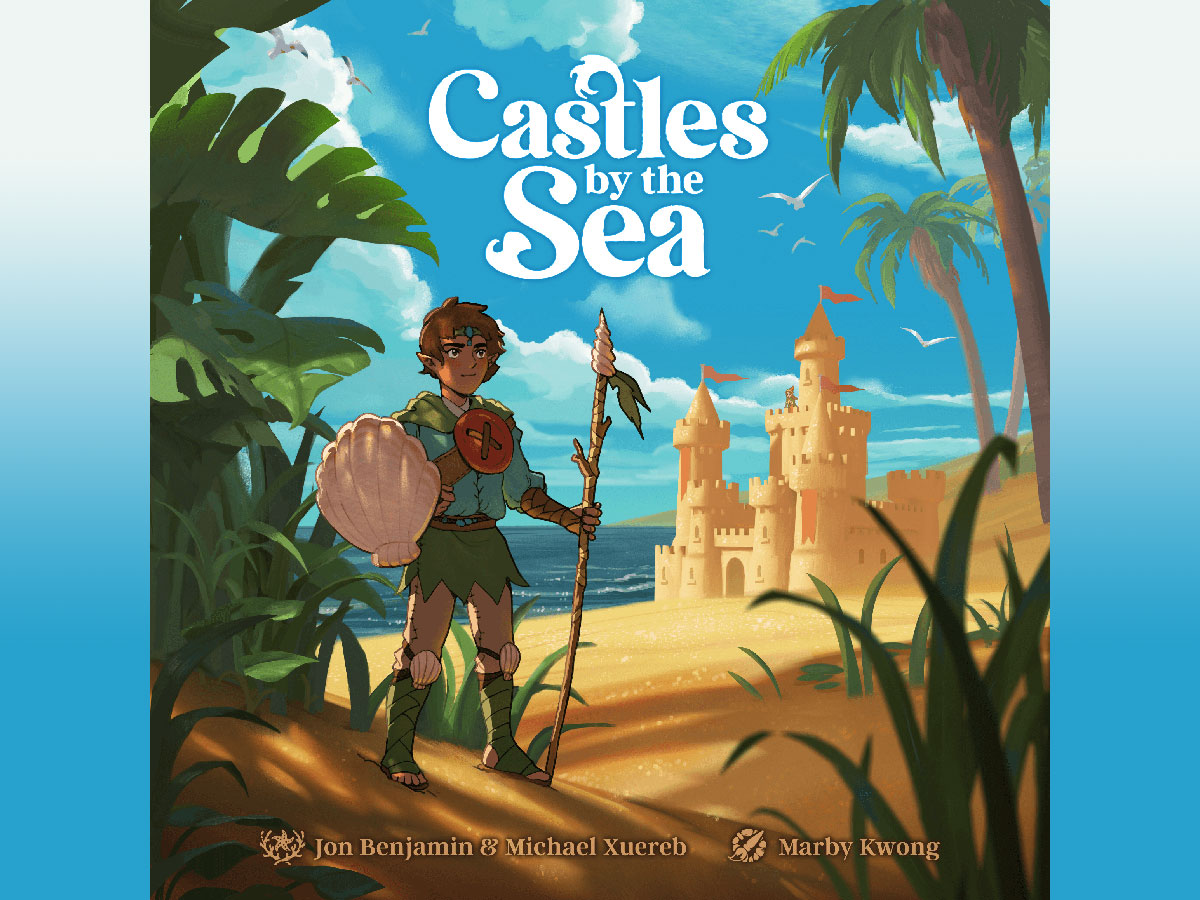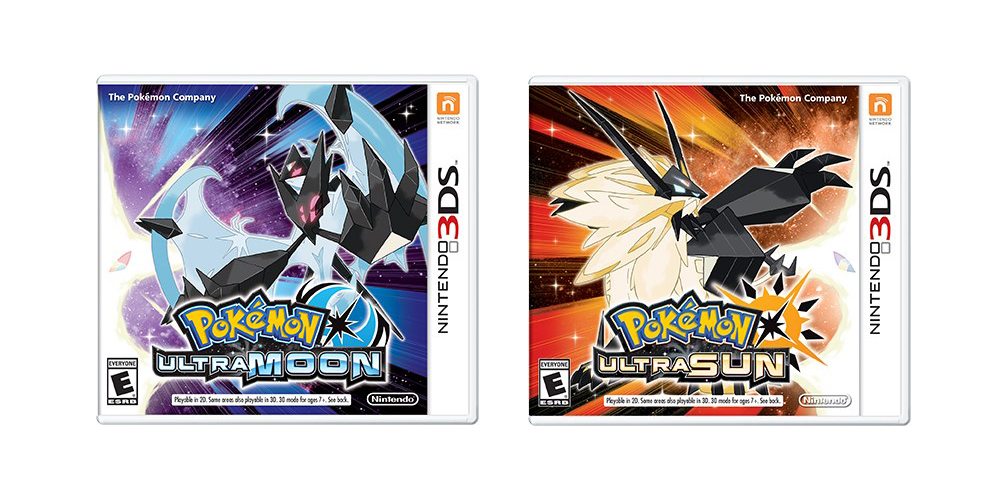Build up your sand castles to claim territory for your Shorelings kingdom … but beware of the many hazards that may topple your towers!
What Is Castles by the Sea?
Castles by the Sea is a building game for 1 to 4 players, ages 12 and up, and takes about 30–45 minutes to play. It’s currently seeking funding on Kickstarter, with a pledge level of $45 for a copy of the game; there’s a $55 pledge level that includes the Riptide Expansion, and a $65 pledge level with upgraded components.
Castles by the Sea was designed by Jon Benjamin and Michael Xuereb and published by Brotherwise Games, with illustrations by Marby Kwong.
New to Kickstarter? Check out our crowdfunding primer.
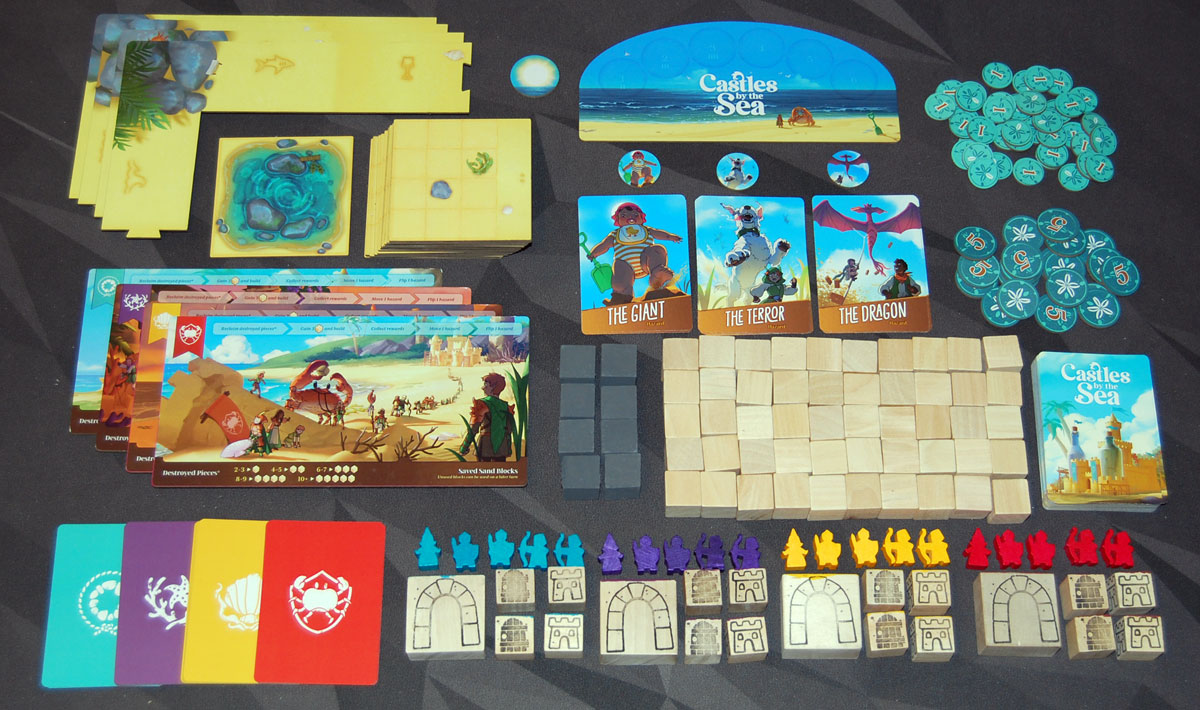
Castles by the Sea Components
Note: My review is based on a prototype copy, so it is subject to change and may not reflect final component quality. The prototype (and my photos) do not include some of the components that are being revealed during the Kickstarter campaign. (The campaign page says the game will work for 1 player, but the prototype did not have solo mode rules yet so I’ve only played the multiplayer version.)
The base game will include:
- Modular game board
- 4 Player boards
- 4 sets of player pieces:
- 1 Princess
- 2 Guards
- 2 Archers
- 2 Doors
- 2 Towers
- 1 Arch
- 24 Player cards (plus variant cards)
- 5 Sets of Hazard cards and tokens
- 26 Castle cards
- 50 Sand blocks (natural wood)
- 8 Stone blocks (painted grey wood)
- 8 Seaweed tokens
- 60 Sand Dollar tokens
- Turn Counter and marker
The Riptide Expansion adds some tide markers, more cards, a hazard board, and a die. The Deluxe edition also includes the Riptide Expansion, and upgrades the cardboard Hazard tokens to wooden pucks. It also has printed meeples—each of the four player colors has its own design.
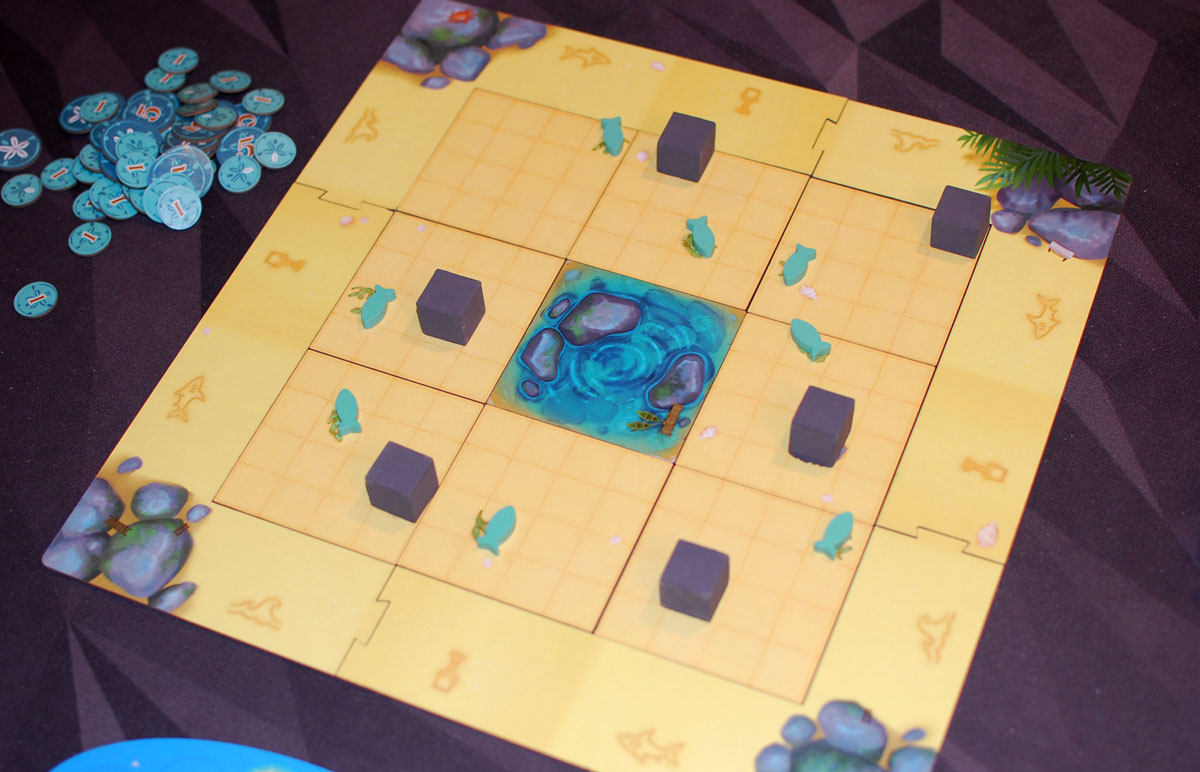
The modular board depicts an area of sandy beach with a tide pool in the center, and the eight surrounding squares can be swapped out depending on the number of players to increase or decrease the available building spaces.
The sand and stone blocks are large wooden cubes—big enough to stack up pretty easily (this isn’t a dexterity game!) and the natural wood color really goes well with the sand castle theme. The player structures are also wooden blocks, printed on the sides with a picture of the structure, and painted on the top surface with the player color. That makes them easy to spot once they’re mixed in with everything else, but still keeps the majority of the structure sand-colored.
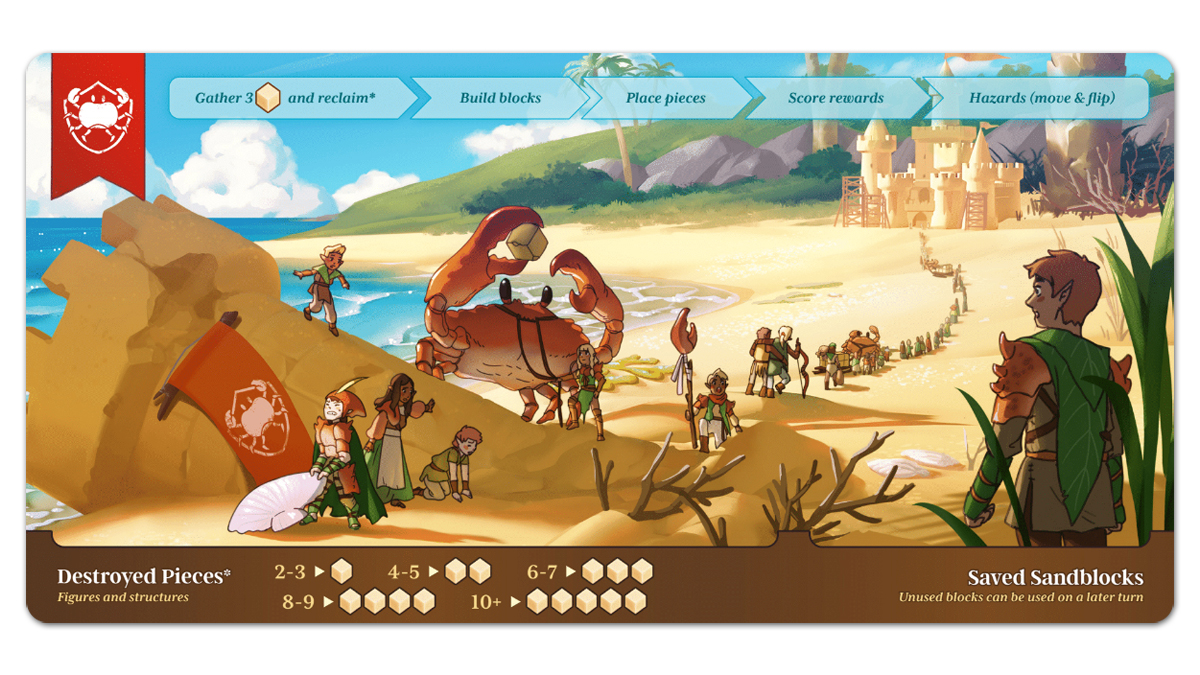
The meeples are custom shapes: archers holding a bow, guards with a shield and spear, and a princess with a pointy hat (though the names of these characters may change based on the cards used each time you play). The associated cards have illustrations by Marby Kwong, with variant cards that can be swapped out for the various characters. I really love these illustrations, which look like something from a Studio Ghibli film—it really helps you envision this world of tiny characters who live on the beach, terrorized by dogs and babies and kites. I only wish that there were even more of her artwork in the game itself. There are characters depicted on the cards, and some larger scenes on the player boards, but most of the rest of her artwork is in the rulebook but not actually displayed on the table.

The player cards for structures show the structure itself, along with spaces that must be occupied or empty, showing the conditions that must be met to build the structure. Each of the player cards has a spot where the block or meeple is stored, with sand dollar icons that are revealed when the piece is removed, making your scoring really easy to add up.
The player boards have a turn order reminder and are a place for you to store destroyed pieces and unused sand blocks, but I have to admit that they’re not totally necessary. That said, since they’re one of the few places that have Marby’s illustrations, I’m glad they’re there.
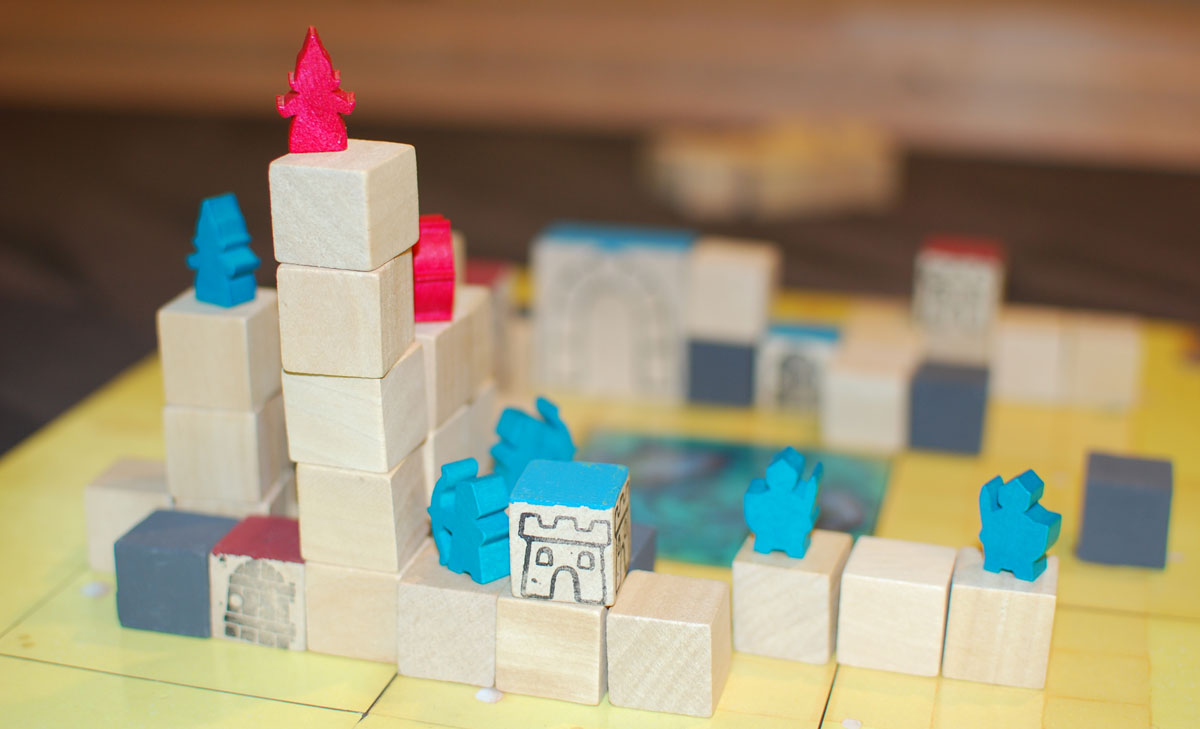
How to Play Castles by the Sea
You can download a copy of the rulebook here.
The Goal
The goal of the game is score the most points by placing your structures and Shorelings onto the board, gathering seaweed, and completing castle cards.
Setup
Set up the modular board based on the number of players, placing a stone block on each stone icon and a seaweed token on each seaweed icon. Set the supply of sand blocks nearby. Place the turn counter nearby, with the turn marker on the starting space based on the number of players. Shuffle three hazard decks individually and place them below the turn counter. Place the three hazard markers on random spaces on different sides of the board.

Each player gets a player board, all of the structures and meeples of their color, and six player cards. The player cards are set out in front of them, with the corresponding pieces placed on the sand dollar spaces. Each player is dealt 3 castle cards. Choose a starting player at random.
Gameplay
On your turn, you do the following:
- Gather sand blocks from the supply—3 blocks, plus 1 for every 2 destroyed pieces on your player board.
- Build your sand blocks; all of the blocks you place in one turn must be touching each other. You may reserve blocks.
- Place structures and figures, as many as you wish, as long as they fulfill the building requirements.
- Score sand dollars based on the number of icons that are revealed on your cards.
- Move and activate hazards: move one token clockwise to the next edge (any available space), and then flip one of the other hazard cards. (In a 2-player game, you flip both other hazard cards.)
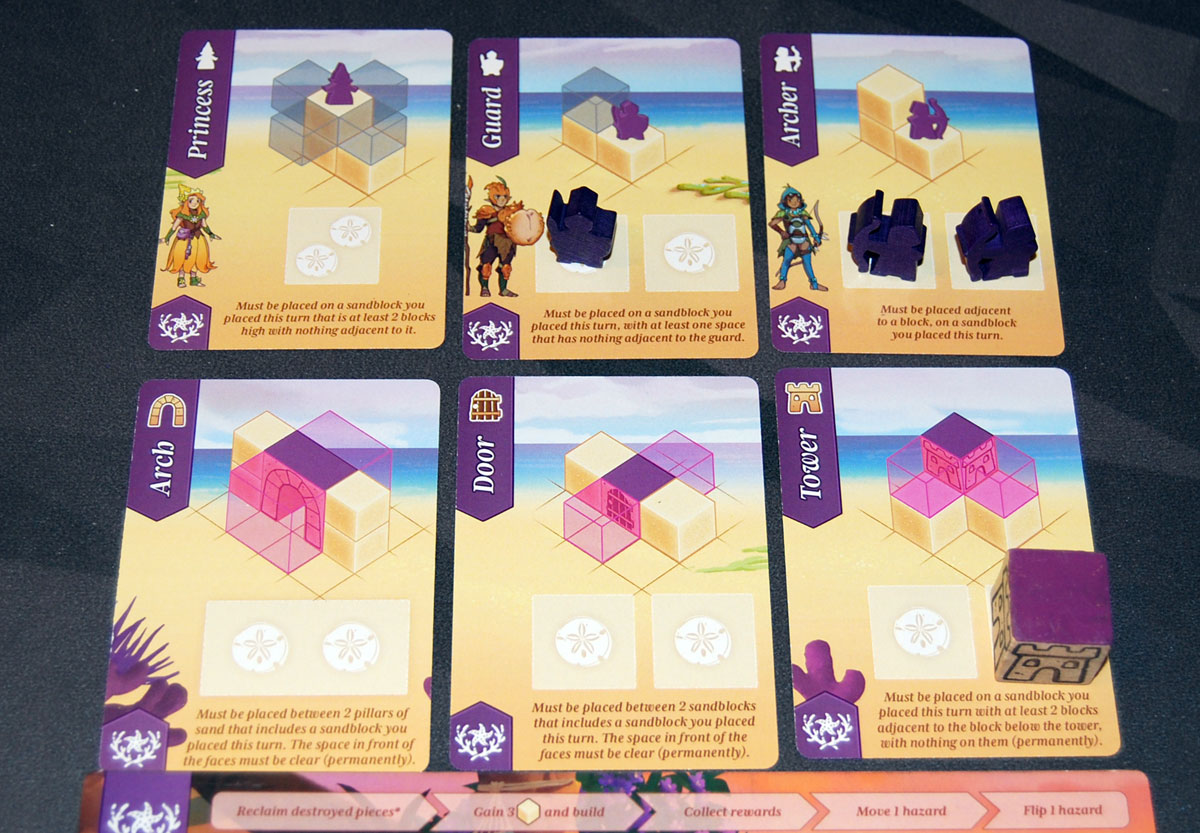
Each structure has a card that tells you what’s required to build it, and they must be connected to a sand block that you just placed this turn—but often will also require you to build off blocks that were placed previously, either by yourself or another player. The Shorelings must be placed on top of sand blocks that you placed this turn, according to their requirements. For instance, the archer needs some cover so it always needs to be next to another block, but the guard wants room to patrol so it needs to be next to at least one empty space. Seaweed tokens are worth 2 points each, and you pick them up if you place a sand block on them.

Each player also has 3 castle cards, kept secret until they’re fulfilled. During your turn, if you place something that fulfills the requirement of a castle card, then you can reveal it, and will score the points listed at the bottom. Some cards require you to complete a particular shape, and others have text requirements like “have all of your structures on the board but none of your figures.” Note: you may only score 2 of the 3 cards during the game, so choose wisely!

At the end of your turn, you’ll move one hazard around, and then flip a card for another hazard. The hazard cards have from 0 to 3 “danger” icons at the bottom of the card. As soon as 3 or more icons have accumulated, that hazard strikes. Otherwise, the revealed cards are just stacked so all the icons are visible. Each hazard has a different effect: the dog will destroy everything in the square it faces, and the baby removes all the figures in the entire lane that it faces. Once a hazard strikes, you move it clockwise to the next available matching icon, and reshuffle the cards.
After everyone has had a turn, move the turn counter.
Game End
After the turn counter reaches the end, everyone in turn order does the hazard step one more time, and then everyone gathers sand blocks for destroyed pieces and scores one more time.
The highest score wins, with ties going to the player with more sand blocks saved, and then to the player earliest in turn order.
Why You Should Play Castles by the Sea
I’ll preface my verdict with the disclaimer that I’ve only gotten to play Castles by the Sea a couple times so far since I was waiting for my turn with the prototype, but I did get to try it at both 2 players and 4 players to get a sense of how the game works. The prototype includes just three of the hazards and only the base set of recommended player cards, so it gave me an idea of what the game will feel like when you start out, before you throw in some of the variations.
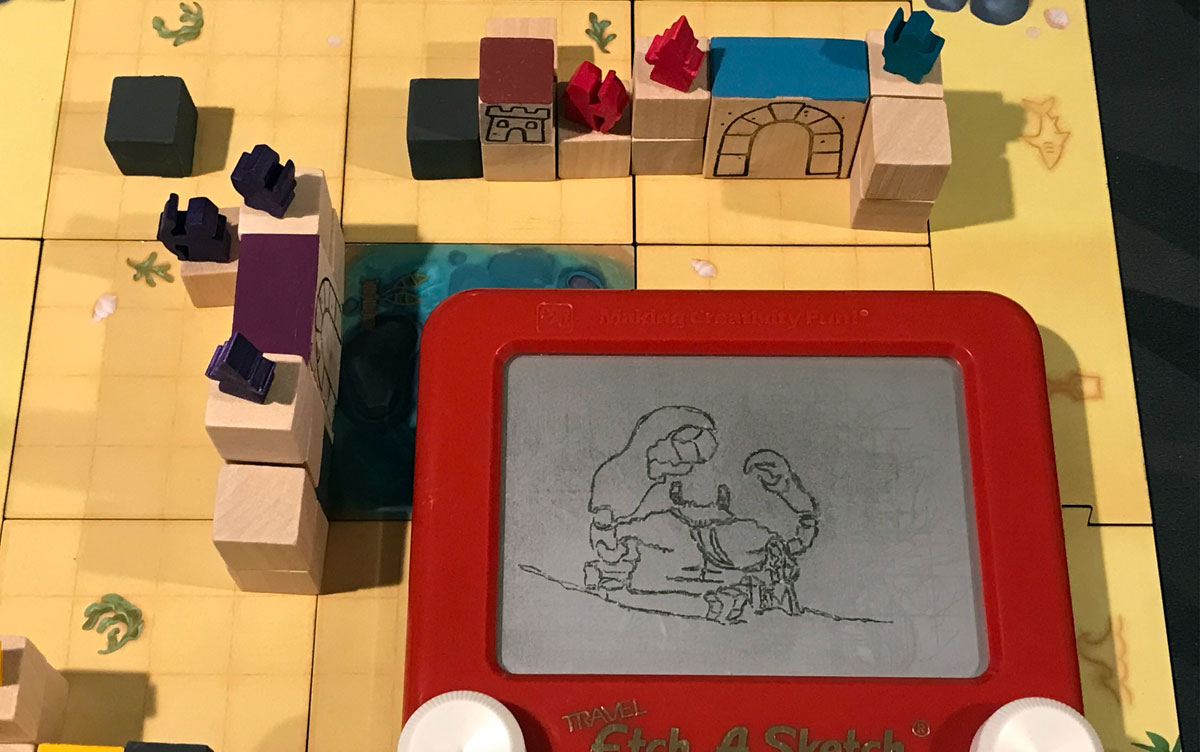
I really love the world depicted by the game: while the game could have been mechanically the same with just kids building sand castles on the beach, the story of the Shorelings (combined with Marby’s fantastic artwork) raises the stakes. It’s not just a little figurine that gets snatched by the toddler (known as The Giant)—that’s a person who just got carried away to who knows where! It gives the setting a bit more weight to it, knowing that you’re trying to build a castle to protect these tiny citizens, and it makes you care about it in a different way. Plus, you know, tiny people wearing crab shell armor is always cool.
The game does a good job of capturing that feeling of trying to build a castle while various outside forces conspire to knock things down, whether it’s a stray dog (“The Terror”) or the incoming tide. There’s a nice ebb and flow as you build up, score points, and then retrieve your pieces from the wreckage so you can build again. That said, if you’re the sort of person who likes to be able to build things in a game and hate having them taken apart, Castles by the Sea might be a bit frustrating for you.
You’ll have to decide on your approach. You could try to concentrate most of your buildings in one place, hoping to maneuver the hazards away before they strike. Or you could spread out your pieces, sharing space with as many other players as possible—not only are other players less likely to trigger an attack that might hurt themselves, but if you get hit you won’t lose quite as much in one blow. On the other hand, if you’ve got pieces everywhere, then it also means that every hazard is a risk for you.
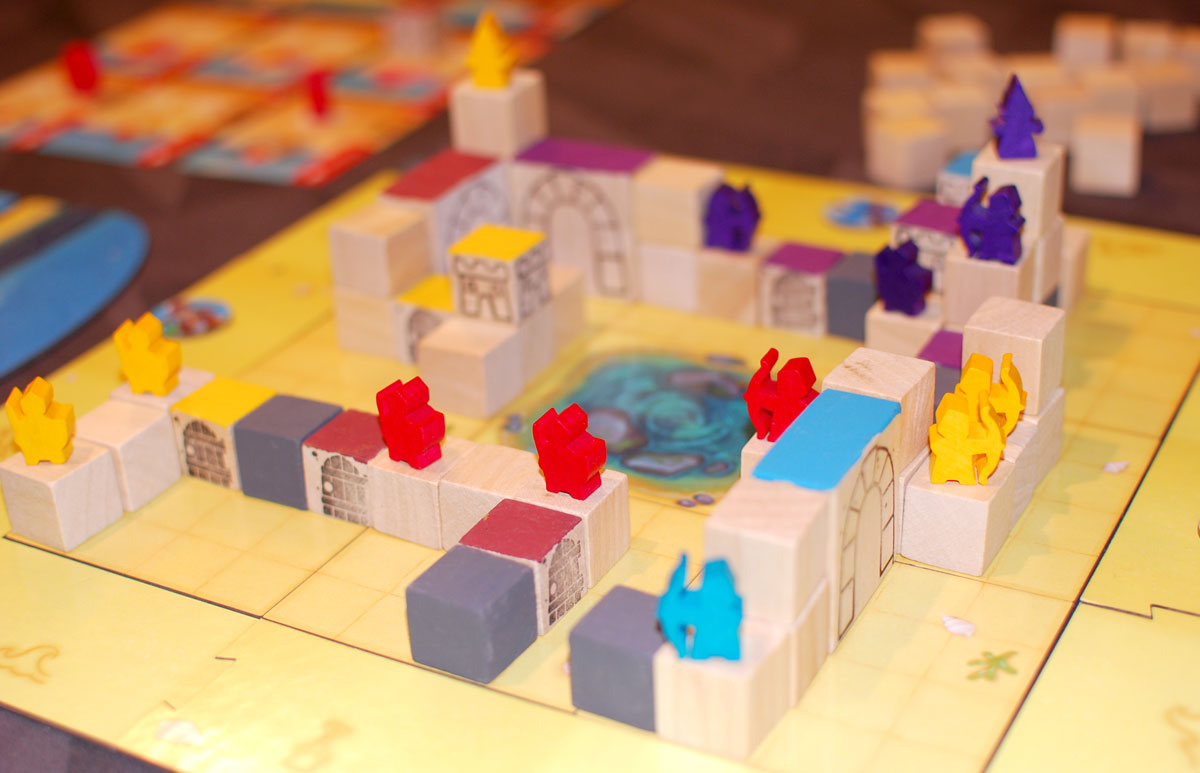
Each hazard has a particular attack, but there’s still an element of unpredictability. For instance, you know that when the dog strikes, it will remove everything in the square right in front of it. What you don’t know is how many cards it will take before it strikes: each deck has one card with no danger and one card with 3, and then two cards each with 1 and 2 danger. So there’s always a slim chance that the first card flipped can result in an attack, but it could also take as many as 4 cards before a strike. On each turn, you get to move one hazard and you know that card won’t get flipped, so there can often be some tough decisions about what you move and what you leave, depending on which cards you think the next player will flip. In a 2-player game, this gets particularly tense, because you move one hazard and flip both of the others, and you whatever positions you leave the hazards in is what your opponent gets to use against you since there aren’t other players.
I’ve been following along with the Kickstarter campaign, where they’ve been unveiling additional player cards that you can swap in. For instance, if you use the Monument card, the archway block is now something that has to be built with nothing touching it at all—that makes it easier to place, but it’s only worth 1 sand dollar (instead of the Arch’s 2). On the other hand, you get a bonus of 3 sand dollars on the turn you place it. That means you want it to get knocked down, so you can place it again and again. There are also character cards that replace the archers, guards, and princess, with different placement requirements. Each game, you’ll use a combination of six cards, and that will change the feel of the game.
Castles by the Sea may be a bit more frustrating if you have trouble with 3-dimensional puzzles and have trouble picturing how to place and rotate things in your mind, but even so your gaming group may be more flexible and allow you to try out placements before finalizing your move. For folks who enjoy spatial puzzles, however, Castles by the Sea is like a playground (or should I say sandbox?). It’s a fun challenge trying to figure out how to use a limited number of sand blocks to set up as many structures and figures as possible, while also grabbing those seaweed tokens and trying to limit your exposure to hazards. Unlike many block-stacking games, it isn’t a dexterity game (though some dexterity helps, of course): it’s about plotting out your build, not making it sturdy. (Although I do think it would be entertaining to have some sort of flicking or throwing based hazard—here comes the beach ball!)
For more information or to make a pledge, visit the Castles by the Sea Kickstarter page!
Click here to see all our tabletop game reviews.
![]() To subscribe to GeekDad’s tabletop gaming coverage, please copy this link and add it to your RSS reader.
To subscribe to GeekDad’s tabletop gaming coverage, please copy this link and add it to your RSS reader.
Disclosure: GeekDad received a prototype of this game for review purposes.
